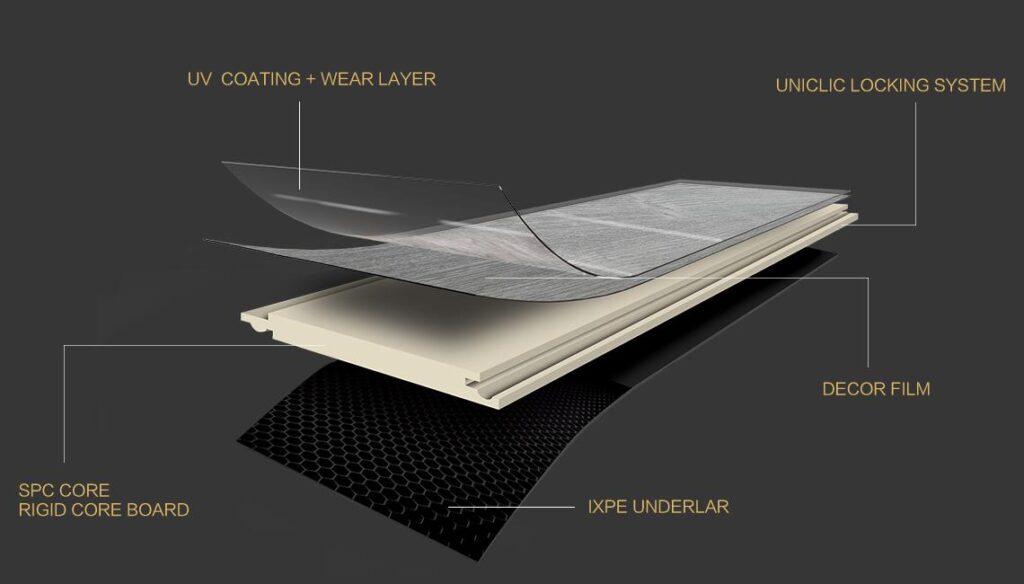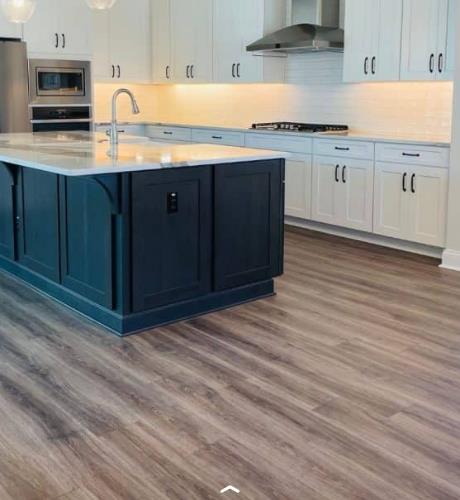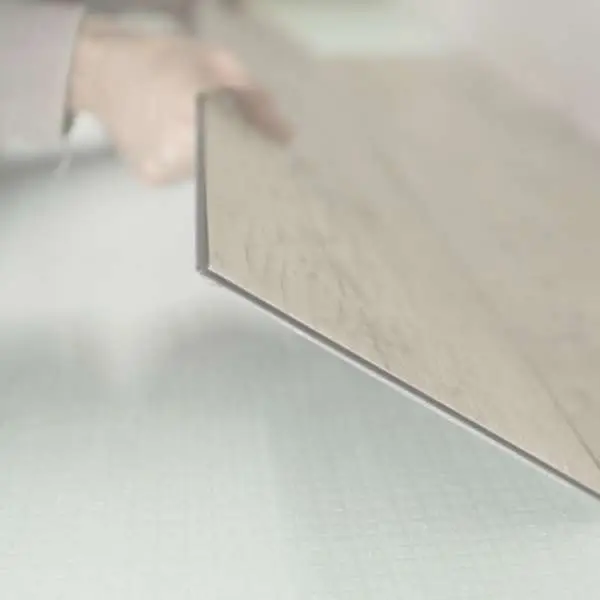Are you tired of compromising between style and durability when it comes to your flooring? Well, get ready to be blown away by the latest revolution in the flooring industry – the rise of rigid core flooring products. This innovative flooring solution offers the ultimate combination of durability and style, making it the perfect choice for any modern home.
With its rigid core construction, this type of flooring is incredibly strong and resistant to dent and scratches. It can withstand heavy foot traffic, making it ideal for high-traffic areas such as hallways and kitchens. Rigid core flooring also comes in a wide range of stunning designs and finishes, allowing renovation projects to create the perfect look for any residential homes.
Whether you prefer the timeless beauty of natural wood or the sleek elegance of stone, rigid core flooring has got it all. Further more, with its easy installation process, the time and experience to install the flooring is fool proof with minimal time required. A great flooring solution that ticks with any floor interior demands.
Experience the rise of rigid core flooring and discover the ultimate combination of durability and style.
What sets rigid core flooring apart from other types of flooring?
Rigid core flooring stands out in the crowded flooring market primarily due to its unique construction that combines a robust core with an attractive surface layer. Unlike traditional laminate or vinyl flooring, rigid core flooring features a solid, durable core made from materials such as PVC or composite materials, which provides exceptional stability and strength. This rigidity allows it to withstand the stresses of daily use without warping or bending under pressure. Its design makes it an excellent choice for areas prone to moisture, as it is less likely to buckle or swell compared to standard hardwood or laminate options.

Another distinguishing feature of rigid core flooring is its ease of installation, which often employs a click-lock mechanism that allows for a floating installation. This means that the planks can be laid directly over most existing floors without the need for glue, nails, or staples. Such a feature not only simplifies the installation process but also reduces the time and labor costs involved. Additionally, the ability to install it over various substrates, including concrete and tile, makes it a versatile choice for many homeowners looking to upgrade their spaces without extensive renovations.
Moreover, rigid core flooring offers a combination of aesthetics and functionality that appeals to a wide range of design preferences. Available in an array of styles, colors, and textures, it can mimic the appearance of natural materials like wood and stone without the associated maintenance challenges. The technology behind its printing and texture allows for highly realistic designs that can transform any room into a stylish retreat. This fusion of durability, easy installation, and design versatility sets rigid core flooring apart from other flooring options in the market.
Benefits of Rigid Core Flooring
Rigid core flooring brings a plethora of benefits that make it an attractive flooring solution for homeowners and commercial spaces alike. One of the most notable advantages is its remarkable durability. The strong core construction allows it to resist scratches, dents, and stains, making it an ideal choice for high-traffic areas such as hallways, living rooms, and kitchens. This resilience means that it can maintain its appearance and functionality for years, even in the face of heavy use, reducing the need for frequent replacements or repairs.
Another significant benefit is the exceptional moisture resistance that rigid core flooring provides. Many types of flooring can suffer in humid environments or areas prone to spills, but rigid core options are specifically designed to perform well under these conditions. This characteristic makes them suitable for spaces like bathrooms, laundry rooms, and basements where moisture can be a concern. Homeowners can enjoy peace of mind knowing that their flooring will not warp or buckle due to dampness, allowing them to maintain a beautiful and functional home.
In terms of comfort, SPC flooring often incorporates an attached underlayment that enhances sound absorption and provides a softer feel underfoot. This can be particularly beneficial in multi-story homes where noise transfer between floors is a concern. The cushioning effect not only adds comfort but also contributes to a warmer feel, making it a cozy option for living spaces. Overall, the combination of durability, moisture resistance, and comfort makes rigid core SPC an exceptional choice for anyone looking to enhance their home environment.
In summary, the benefits can be listed as below:
- Rigid Durability of Plank.
- Resist to Scratches & Dents.
- Easy to maintain from stains, dirt, and generic chemicals.
- Aesthetic appearance and design.
- Easy to be installed, remove, or replace.
- Water and moisture resistance. (While the SPC composition are waterproof itself).
- Dimensional Stable compare to hardwoods.
- Enhanced sound absorption with underlayment.
Different Types of Rigid Core Flooring
When exploring rigid core flooring, it’s essential to understand that it primarily comes in two distinct types: Stone Plastic Composite (SPC) and Wood Plastic Composite (WPC). Each of these types has its unique features and benefits, catering to different preferences and needs in flooring solutions. SPC flooring is known for its superior durability and resistance to moisture, making it an excellent choice for high-traffic areas and spaces that experience humidity. The core is made from a blend of limestone and PVC, resulting in a product that is both sturdy and waterproof.
On the other hand, WPC flooring provides a more comfortable underfoot experience due to its thicker core, which typically includes a foam layer. This type is ideal for residential settings where comfort is a priority, as it offers a softer feel that can be more forgiving on the feet during long periods of standing. WPC is also known for its sound-dampening properties, making it a great choice for family homes or apartments where noise can be an issue. Both SPC and WPC options come in a wide variety of styles, colors, and textures, allowing homeowners to find the perfect match for their design vision.
Additionally, there are variations within these categories that may include enhanced features such as enhanced UV protection, anti-microbial properties, or even added layers for increased durability. Some brands offer rigid core flooring with a more textured surface to better mimic natural wood or stone, providing a more authentic look and feel. With such diverse options available, homeowners can select the type of rigid core flooring that best fits their lifestyle and aesthetic preferences, ensuring they achieve the desired balance of style and functionality in their spaces.
Choosing the right rigid core flooring for your space
Selecting the right rigid core flooring involves several considerations to ensure it complements your home’s design while meeting practical needs. First and foremost, evaluate the specific areas in your home where the flooring will be installed. High-traffic areas like hallways, kitchens, and living rooms benefit from more durable options like SPC, which can resist wear and tear effectively. In contrast, for spaces that prioritize comfort, such as bedrooms or playrooms, WPC flooring may be more suitable due to its softer underfoot feel.
Next, consider the aesthetic aspects of your flooring choice. Rigid core flooring is available in a plethora of designs, from realistic wood grains to elegant stone finishes. Think about the overall theme of your home and how the flooring will tie into that vision. If you have a modern home, minimalist designs with light colors might be the perfect fit, while traditional homes could benefit from the warmth of rich wood tones. Don’t forget to factor in the size of the room; lighter colors can make smaller spaces feel larger, while darker tones can add warmth and coziness to larger areas.
Lastly, don’t overlook the practical considerations related to installation and maintenance. While most rigid core flooring options are designed for easy DIY installation, some may require additional tools or techniques. Reading through the manufacturer’s guidelines can help you determine if you need professional help or if you can tackle the project yourself. Additionally, consider the maintenance requirements of the flooring you choose. Rigid core flooring generally requires minimal upkeep, but some finishes may be more resistant to scratches or stains than others. This can affect your long-term satisfaction with the flooring, so choose wisely based on your lifestyle and maintenance preferences.
Installation Process for Rigid SPC Flooring
The installation process for rigid core flooring is one of its most appealing attributes, primarily due to its straightforward approach that caters to both DIY enthusiasts and professional installers. Before beginning the installation, it’s essential to prepare the subfloor adequately. The surface should be clean, dry, and free of any debris to ensure a smooth installation. If there are any significant imperfections in the subfloor, they should be addressed, as these could impact the performance and appearance of the finished floor. In some cases, it might be wise to lay an underlayment, especially if sound absorption or moisture protection is a priority.
Once the subfloor is ready, the actual installation process can commence. Rigid core flooring typically utilizes a click-lock system, which allows planks to fit together easily without the need for glue or nails. Start by laying the first row of planks along the longest wall, ensuring they are aligned correctly. As you continue to lay additional rows, stagger the seams between planks to create a natural look, resembling traditional wood flooring. This staggering not only enhances aesthetics but also contributes to the overall stability of the floor.
After laying the flooring, it’s crucial to allow the planks to acclimate to the room’s temperature and humidity for a few days before any heavy use. This step helps minimize expansion or contraction that can occur after installation. Finally, once the flooring is installed, it’s often recommended to install baseboards or trim to finish the look and cover any gaps at the edges. This seamless transition between the floor and the walls enhances the overall aesthetic and gives the room a polished, finished appearance. With the right preparation and attention to detail, the installation of rigid core flooring can be a rewarding and relatively simple project.
Maintenance and care tips for rigid SPC flooring
Maintaining rigid core flooring is straightforward, thanks to its durable nature and resistance to stains and scratches. However, regular cleaning and proper care are essential to prolong its lifespan and keep it looking its best. Start with routine sweeping or vacuuming to remove dirt and debris that can accumulate on the surface. Using a soft-bristle broom or a vacuum with a hard floor setting is ideal to avoid scratching the finish. This simple step can prevent dirt from embedding into the flooring and can make a significant difference in the longevity of the surface.
For deeper cleaning, it’s advisable to use a damp mop with a manufacturer-recommended cleaner specifically designed for rigid core flooring. Avoid using excessive water, as standing water can damage the core material over time. Instead, opt for a slightly damp mop to pick up stubborn spots or stains. Additionally, steer clear of harsh chemicals or abrasive cleaners, as these can harm the finish and diminish the flooring’s aesthetic appeal. Regular maintenance should also include checking for any signs of wear or damage, ensuring that any minor issues are addressed promptly to prevent further deterioration.
Lastly, consider placing mats or rugs in high-traffic areas and entryways to help protect the flooring from scratches and dirt. Using furniture pads under heavy furniture can also prevent indentations and damage to the floor’s surface. By taking proactive steps in the care and maintenance of your SPC flooring, you can enjoy its beauty and durability for many years to come, ensuring it remains a stunning feature of your home.
Popular brands and manufacturers of SPC flooring

The market for rigid core flooring has expanded significantly, leading to a plethora of brands and manufacturers offering innovative products to meet the growing demand. One of the standout names in this category is Mohawk, known for its extensive range of flooring options and high-quality construction. Mohawk’s rigid core SPC flooring utilizes advanced technology in its design, providing stunning visuals and exceptional durability. Their product lines often include options with enhanced moisture resistance and realistic textures, making them a popular choice among homeowners.
Another notable brand is COREtec, which specializes in premium rigid SPC flooring. COREtec products are designed with a unique locking system and a waterproof core, making them ideal for a variety of applications, including residential and commercial spaces. Their commitment to innovation is reflected in their diverse range of styles, ensuring there’s something for everyone. Additionally, COREtec flooring often features a cork underlayment, providing added comfort and sound insulation, which appeals to many homeowners seeking a quieter living environment.
Lastly, Shaw is a well-respected name in the flooring industry, offering an impressive selection of rigid core flooring options. Shaw’s products often combine advanced manufacturing techniques with trendy designs, ensuring that customers can find the perfect flooring to match their style. Their focus on sustainability and environmental responsibility also resonates with many consumers looking to make eco-friendly choices for their homes. With a commitment to quality and design, Shaw continues to be a leading player in the rigid core flooring market.
Comparing SPC flooring to other flooring options
When considering flooring options, it’s essential to compare rigid core flooring to traditional choices like hardwood, laminate, and tile. One of the most significant advantages of rigid core flooring is its durability. Unlike hardwood, which can be susceptible to scratches, dents, and moisture damage, rigid core flooring is engineered to withstand heavy foot traffic and resist wear over time. This makes it an ideal choice for busy households or commercial settings where durability is paramount.
In terms of installation, rigid core flooring offers a simpler process compared to many traditional flooring options. Hardwood and tile often require professional installation, which can be time-consuming and expensive. The click-lock installation method of rigid core flooring allows for a DIY approach, saving time and money while still delivering a high-quality finish. Additionally, the ability to install it over existing floors without the need for extensive preparation can significantly reduce renovation costs and downtime.
Cost is another critical factor to consider when comparing flooring options. SPC flooring typically falls within a mid-range price point, often making it more affordable than solid hardwood while still providing a high-end appearance. With its long lifespan and reduced maintenance costs, rigid core flooring can be a cost-effective solution in the long run. While many homeowners appreciate the aesthetic appeal of natural materials, the realistic designs and finishes of rigid core flooring offer a comparable look at a fraction of the cost, making it an attractive alternative.
Conclusion: Why SPC flooring is the ultimate choice for durability and style
In conclusion, rigid core flooring epitomizes the ideal blend of durability and style, making it a top choice for modern homeowners and businesses alike. Its robust construction ensures it can withstand the rigors of daily life, making it resistant to scratches, dents, and moisture. This resilience not only contributes to a longer lifespan but also ensures that the flooring maintains its aesthetic appeal over time, providing a beautiful foundation for any space.
The versatility of rigid core resilient flooring allows it to cater to a wide range of design preferences, offering options that mimic the look of natural wood, stone, or even contemporary designs. This aesthetic flexibility means that homeowners can achieve their desired style without sacrificing functionality. Coupled with its straightforward installation process and low maintenance requirements, rigid core flooring proves to be a practical solution for busy lifestyles.

Ultimately, the rise of SPC flooring signifies a shift in the flooring industry towards products that meet the demands of modern living. By combining durability, ease of installation, and stunning design options, rigid core flooring stands out as the ultimate choice for those seeking a flooring solution that truly ticks all the boxes. Whether you are renovating your home or considering new flooring for a commercial space, rigid core flooring is a smart investment that delivers on both performance and style.
